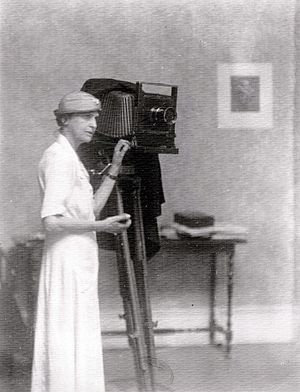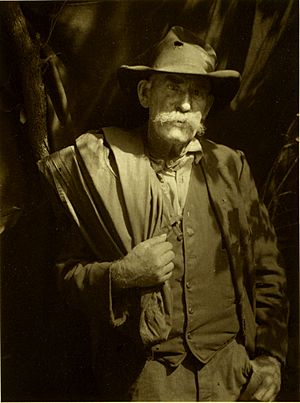Doris Ulmann facts for kids
Quick facts for kids
Doris Ulmann
|
|
|---|---|

Ulmann c. 1910
|
|
| Born | May 29, 1882 New York City, New York
|
| Died | August 28, 1934 (aged 52) New York City, New York
|
| Education | Ethical Culture Fieldston School, Clarence H. White School of Modern Photography |
| Occupation | Photographer |
| Parent(s) | Bernhard and Gertrude (Mass) Ulmann |
Doris Ulmann (born May 29, 1882 – died August 28, 1934) was an American photographer. She is best known for her amazing portraits of people from the Appalachian region. She especially photographed skilled craftspeople and musicians. She took these pictures between 1928 and 1934.
Contents
Life and Photography Work
Early Life and Training
Doris Ulmann was born in New York City. Her parents were Bernhard and Gertrude Ulmann. She went to the Ethical Culture Fieldston School. This school believed that every person was important, no matter their background. She also studied at Columbia University. At first, she planned to become a psychology teacher.
Photography started as a hobby for Doris. But after 1918, she decided to become a professional photographer. She studied at the Clarence H. White School of Modern Photography. Other famous photographers like Margaret Bourke-White and Dorothea Lange also went there.
Her Unique Photography Style
Doris Ulmann used a style called Pictorialism. This style made photographs look more like paintings or drawings. She was a member of the Pictorial Photographers of America.
Ulmann traveled to the rural parts of the Southern United States. She photographed the mountain people of Appalachia. She also took pictures of the Gullah people from the Sea Islands. She always showed great respect for the people she photographed. She also had a keen eye for different cultures.
Capturing Faces and Stories
Doris Ulmann was very interested in taking portraits. She once said that she was most moved by her "mountaineers." She felt their faces told deep stories. She looked for faces that showed a lot of life and strong character. This is why she often found older faces more interesting.
Her early work included portraits of many famous thinkers, artists, and writers. Some of these were William Butler Yeats, Martha Graham, and Paul Robeson.
Documenting Appalachian Culture
Starting in 1927, Doris Ulmann had help from John Jacob Niles. He was a musician and folklorist. While Ulmann took photos, Niles collected traditional songs.
In 1932, Ulmann began her most important project. She started documenting the folk arts and crafts of Appalachia. This work was for a special book called Handicrafts of the Southern Highlands. It was written by Allen Eaton and published in 1937.
Sadly, Doris Ulmann's health was not good. She became very ill in August 1934 while working near Asheville, North Carolina. She returned to New York and passed away on August 28, 1934.
Her Legacy and Collections
After Ulmann died, a foundation she had created took care of her photographs. A photographer named Samuel H. Lifshey developed her negatives. He made prints from over 10,000 glass plate negatives. These prints were put into albums. John Jacob Niles and Allen Eaton added notes to these albums. They wrote down the names of the people in the photos and when they were taken.
Today, most of Doris Ulmann's work is kept at the University of Oregon Libraries. This collection includes many glass plate negatives and original prints. Berea College also has a large collection of her images. These mostly show the Appalachian region. You can also find her photographs in many museums. These include the Smithsonian and the J. Paul Getty Museum.
The Georgia Museum of Art held a big show of her work in 2018. They also published a large book about her photography. The Library of Congress also has more than 150 of her photographic prints.
Images for kids
See also
 In Spanish: Doris Ulmann para niños
In Spanish: Doris Ulmann para niños



